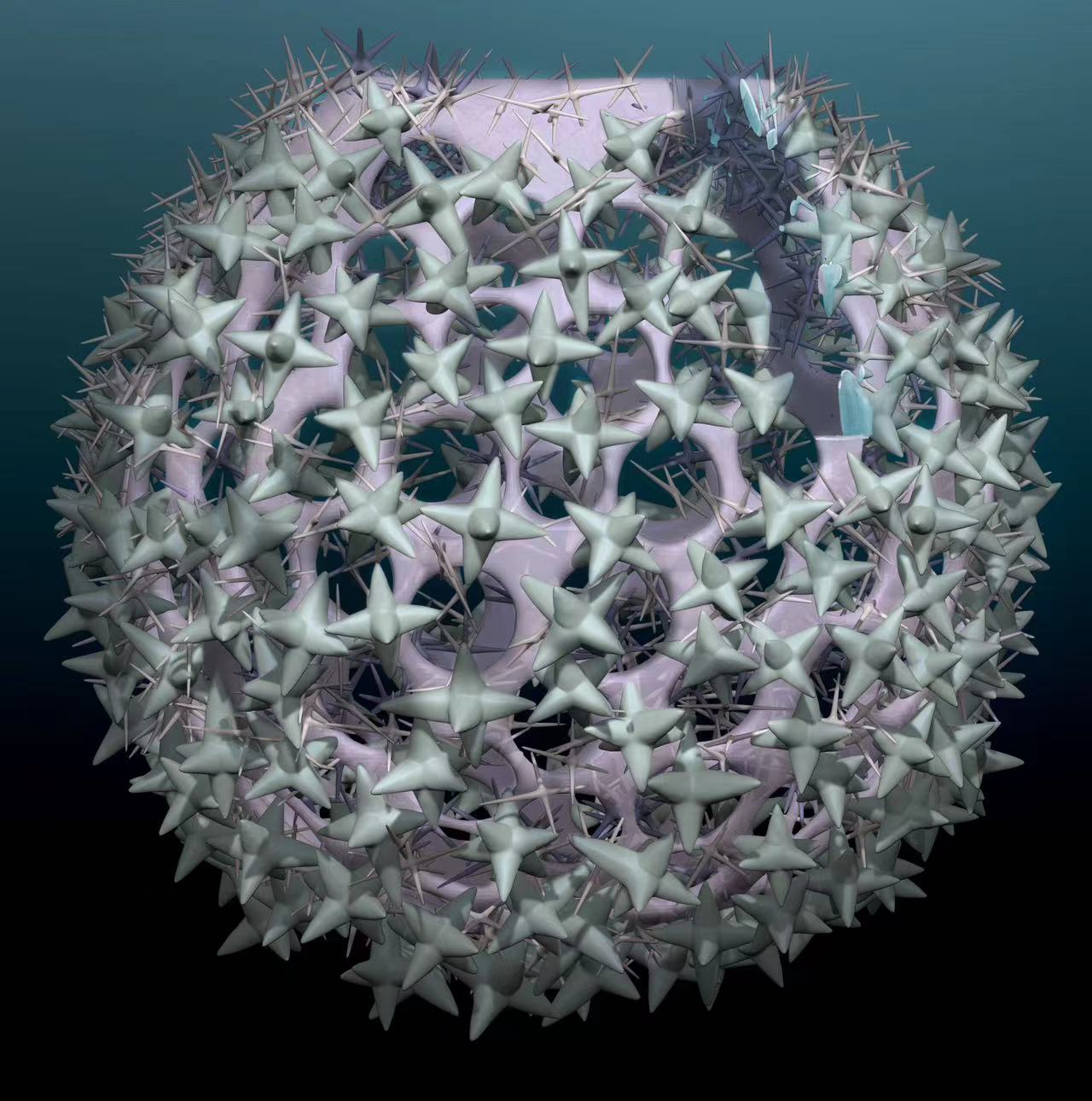Beigong Biota is the first unusual deep-water sponge fauna across the Ordovician-Silurian boundary in the world. It contains abundant and diverse siliceous sponges that perfectly preserved with a nearly complete sponge skeleton. In general, this sponge fauna is a mixture of “old” Cambrian type as well as quite modern ones, showing characteristics of transitional groups. Moreover, it was found in the crucial interval of sponge evolution just between the Cambrian and the Devonian. Thus, further studies about this fauna is super important to reveal a more complete picture of the origin and evolution of Phanerozoic sponges.
Recently, Associate Research Professor LI Lixia and her collaborators from Nanjing Institute of Geology and Palaeontology, Chinese Academy of Sciences (NIGPAS), and University of Gottingen, Germany have conducted detailed studies on taxa of important evolutionary significance of the Beigong Biota. Two new sponge taxa, Turgidaspongia porosa gen. et sp. nov. (Hexactinellida) and Ptilospongia hemisphaeroidalis gen. et sp. nov. (Demospongiae) were first reported from the Beigong Biota. The researchers also explored the biological, palaeoecological and macro evolutionary implications of the new taxa. The research articles were published inHistorical Biology and Estonian Journal of Earth Sciences.
A new stiodermatid (Hexactinellida, Porifera) from the latest Ordovician Beigong Biota
Stiodermatids are a group of hexactinellid sponges with rigid dermal layer, including 13 genera at present with the range extended from the Cambrian to Permian. It should be noted that most of the genera in Stiodermatidae were known from the Carboniferous to Permian. The specimens found earlier than the Carboniferous are mainly preserved as isolated spicules, almost no articulate specimens have been found. As for the Ordovician, even no definite isolated spicules have been reported till now. Due to the sparse fossil record, it is highly debatable that whether there is an evolutionary gap in the lineage of stiodermatids during the Ordovician.
The new stiodermatid discovered from the Beigong Biota strongly suggests that there is no evolutionary gap in the lineage of stiodermatids during the Ordovician, filling the gap in the fossil records of stiodermatids during the latest Ordovician and providing a link between the Cambrian lineage and late Palaeozoic lineage. In light of the new material, all the taxa belonging to the Stiodermatidae are evaluated, combined with the restudying of its taxonomy. A large number of synonym were removed, which were previously established based on isolated spicules.
The number of genera included in Stiodermatidae was reduced from 13 to 5 after reassessment. The uneven distribution of the swollen dermalia in the new species may relate to the sloughing of the dermal spicules causing by the nutrient deficiencyor seasonal development. The unique rigid skeleton structure and unusually large parietal gaps probably represent new attempts on the skeletal evolution of hexactinellids in the Palaeozoic.
The earliest known fossil record of bubarids from the latest Ordovician Beigong Biota
Bubarids are a popular and cosmopolitan demosponge mainly found in the modern deep-water ecosystems, reaching depths of up to 1300 meters. They are characterized by encrusting habit and a two-layer structure of choanosomal skeleton and referred to Halichondrida. At present, all the four genera included in Bubaridae are modern ones, no fossil species have ever been found. Therefore, the origin and evolution of bubarid lineage are still essentially unknown.
A new halichondrid demosponge bubarid is reported from the latest Ordovician Beigong Biota. The new taxon is well-preserved with a two-layer choanosomal skeleton structure (basal layer and erect monactines layer) and three different types of megascleres (styles, strongyles, strongyloxeas), giving an excellent insight into a bubarid affinity and indicating a previously unknown group. The specimen shows almost the overall shape of the whole sponge, giving a reasonably complete knowledge of the structure of the new taxa. Thus, the new genus Ptilospongia is erected with Ptilospongia hemisphaeroidalis gen. et sp. nov as the type species.
Ptilospongia probably represents the only and earliest known fossil record of bubarids, providing new information for understanding the phylogeny of bubarids, and also providing a more reliable calibration point currently available for taxonomic and molecular phylogenetic studies.
The case studies mentioned above just one corner of the Beigong Biota. There are considerable number of taxa in this biota like the above two, representing numerous missing links in the evolution of the Phanerozoic sponge. So, further study on these remarkable sponges could open a new window to investigate the origin and evolution of Phanerozoic sponges
This study was financially supported by the National Natural Science Foundation of China (NSFC) and Strategic Priority Research Program (B) of Chinese Academy of Sciences.
Reference:Lixia Li, Joachim Reitner, Fangyi Gong, Guanzhou Yan, Rongchang Wu. 2023. A new stiodermatid (Hexactinellida, Porifera) from the latest Ordovician of Anhui, South China and its significance for searching the missing link between the Cambrian and late Palaeozoic stiodermatid lineage, Historical Biology, 35(1):116-126.https://doi.org/10.1080/08912963.2021.2024180.
Lixia Li, Joachim Reitner. 2023. A remarkable new halichondrid demosponge, Ptilospongia hemisphaeroidalis, from the latest Ordovician Beigong Biota, South China. Estonian Journal of Earth Sciences, 72(1), 50–53. https://doi.org/10.3176/earth.2023.76.

Fig.1 Turgidaspongia porosa gen. et sp. nov

Fig.2 Reconstruction of Turgidaspongia porosa gen. et sp. nov(Image by YANG Dinghua)

Fig.3 Ptilospongia hemisphaeroidalis gen. et sp. nov.
Contact:
LIU Yun, Propagandist
Email: yunliu@nigpas.ac.cn
Nanjing Institute of Geology and Palaeontology, Chinese Academy of Sciences
Nanjing, Jiangsu 210008, China
Download:
